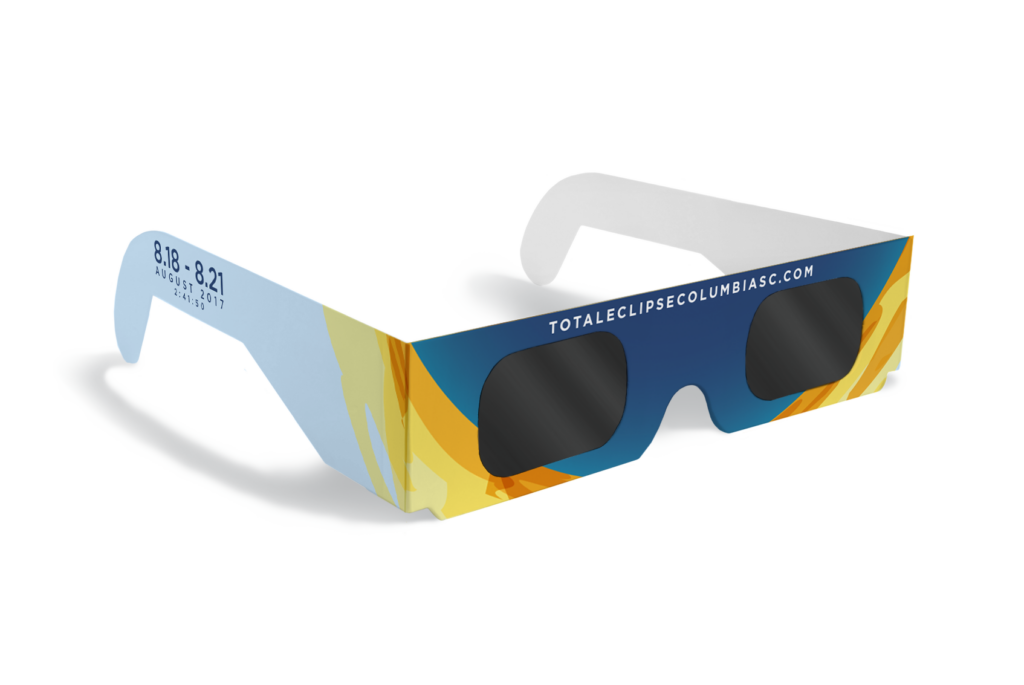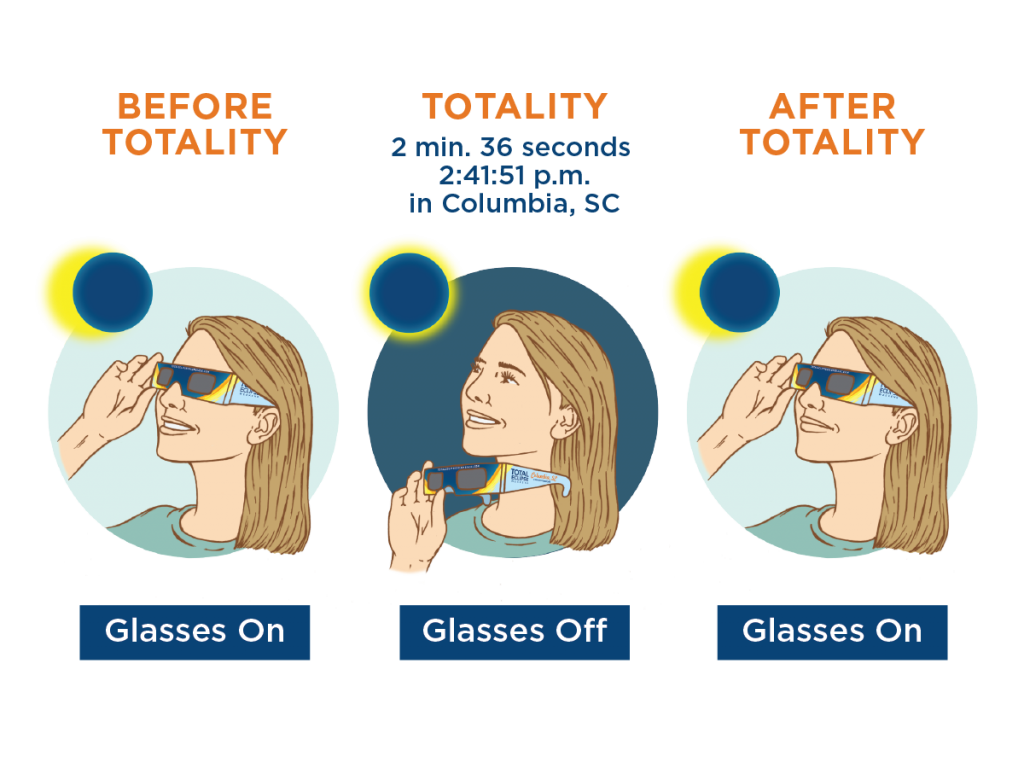
Protect your eyes during the “before and after” partial eclipse phases, but remove your glasses for totality.

“Wear your eclipse glasses for the entire partial phases of the eclipse. During totality, take your eclipse glasses off.”
“As totality begins, it will get dark very quickly and you’ll no longer be able to see the sun through your eclipse glasses. This is your signal that it is completely safe to remove them and look directly at the eclipsed sun.”
“At the end of totality, a bright spot – called the “diamond ring” – will appear on the right side of the sun. When this bright spot appears, put your eclipse glasses back on.” – Matthew Whitehouse, observatory manager at the South Carolina State Museum and total solar eclipse witness
You can create your own pinhole projector!
Note: Eclipse glasses are necessary for looking directly at the sun. (The exception of course, are those 2.5 minutes during totality, when the sky goes dark and you *should* look at the sun!)
Most people do not look directly at the sun in their daily lives; an eclipse day is no different, unless you actively look up at the sun and gaze at it–which we all plan to do with gusto! You do not need eclipse glasses to go about your normal daily routine, however, and by all means, do not drive while wearing the glasses! In fact, don’t do anything but look at the sun while wearing eclipse glasses. Trust.
Remember: remove your eclipse glasses when the sky goes dark during totality, and put them back on to look straight at the sun when daylight returns!
For those wishing to construct their own solar projection viewing devices, visit NASA: https://eclipse2017.nasa.gov/eclipse-viewing
Thinking about photographing the eclipse? Experts advise that we all put down our phones and cameras and enjoy the moment, and let the professional photographers capture the images for us all to savor later. Most people don’t have the right equipment to capture more than a tiny, bright dot. Still curious? Read up on some advice the AAS’ eclipse photography page.
Viewers should consider the same sun safety measures one would employ when spending time outdoors in the summer, such as hats, sunscreen, insect repellent and hydrating beverages.
Eye Safety Info from the American Academy of Opthalmology (AAO)
“Watching a solar eclipse is a memorable experience, but looking directly at the sun can seriously damage your eyes. Staring at the sun for even a short time without wearing the right eye protection can damage your retina permanently. It can even cause blindness, called solar retinopathy.”
“The only time that you can look at the sun without a solar viewer is during a total eclipse. When the moon completely covers the sun’s bright face and it suddenly gets dark, you can remove your solar filter to watch this unique experience. Then, as soon as the bright sun begins to reappear very slightly, immediately use your solar viewer again to watch the remaining partial phase of the eclipse.”
Read the rest of this report by Kierstan Boyd, director of patient education at the AAO, here.
Note: The partial eclipse before and after totality is not visible without glasses, since the sun is still so bright even up to the final moments of the moon covering the sun. It is of crucial importance that anyone planning to watch the partial eclipse leading up to and after totality protect their eyes with certified eclipse viewing glasses or safety film.
IMPORTANT SAFETY ALERT
To address concerns regarding fake or counterfeit eclipse safety glasses, the American Astronomical Society has just issued new guidance advising people to no longer look for language indicating that glasses meet certain safety standards (ISO standards, etc.). There are glasses on the market that have language printed on them indicating that they meet these standards, but many of these glasses have not been tested appropriately.
The American Astronomical Society is now advising people to make sure their eclipse glasses are from reputable manufacturers instead of looking for safety/certification language.
View the list of manufacturers recognized by AAS as safe: https://eclipse.aas.org/resources/solar-filters
You may also be asked if glasses are “NASA approved.” NASA and AAS work closely together.
Note: the free eclipse glasses sponsored by the City of Columbia, S.C., for distribution to guests of most events listed on this site are from Rainbow Symphony, one of the NASA- and AAS-endorsed manufacturers.
“If in doubt about your eclipse glasses, you can either make a pinhole projector or use a cheese grater, colander, pegboard, or even a tree. With your back to the sun, you’ll see multiple shadows of the partial eclipse on the ground (or on a white piece of paper) as the partially eclipsed sun shines through each of the holes in the colander, cheese grater, pegboard or leafy tree canopy onto that surface. These can look really cool! The great thing about being in the path of totality is that regardless of whether or not you have glasses, you can still look directly at the sun when darkness falls during totality. Don’t get too bummed out if you don’t have glasses, as you’ll still get to see the most awesome part.”– Liz Klimek, planetarium manager at the South Carolina State Museum
Got kids? Here is a fun idea for keeping their glasses over their eyes: http://www.doitonadimeblog.com/2017/08/2017-solar-eclipse-for-kids/